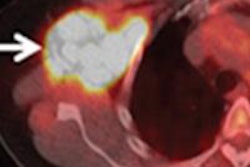NaF-FDG-PET/MRI also detected extraskeletal disease that could change the management of these patients, along with the added benefit of delivering significantly less radiation exposure with lower dosages of PET radiopharmaceuticals.
"We assessed the data to advocate for a new approach to the evaluation of the extent of disease in selected cancer patients, a topic of both significant clinical relevance and applicability to diverse practice settings," wrote Dr. Ryogo Minamimoto, PhD, from Stanford University, in an email to AuntMinnie.com.
The researchers prospectively enrolled more than a dozen patients who were referred for technetium-99m (Tc-99m) methylene diphosphonate (MDP) bone scans. The cohort included men with prostate cancer and women with breast cancer.
PET/MRI was performed six to 30 days after the bone scans. Whole-body MRI included T2-weighted, diffusion-weighted, and contrast-enhanced T1-weighted imaging.
Bone scintigraphy and PET/MRI both showed osseous metastases in nine patients, but PET/MRI discovered more metastases than bone scintigraphy in three patients. All patients tolerated the PET/MRI exam, and the PET images were of diagnostic quality, despite the reduced radiopharmaceutical dose compared to standard protocols.
"Compared to PET/CT, the advantages of PET/MRI are a reduction of radiation exposure, use of MRI to image organ function, and improvement of diagnostic ability due to the better contrast of MR imaging," Minamimoto said.
Given the accuracy of NaF-FDG-PET/MRI for staging patients with breast and prostate cancers prior to treatment, Minamimoto described the hybrid modality as a potential "one-stop shop" in the imaging management of these patients.
The researchers plan to expand their study to include 50 breast cancer and 50 prostate cancer patients, in addition to other cohorts of cancer patients.



















